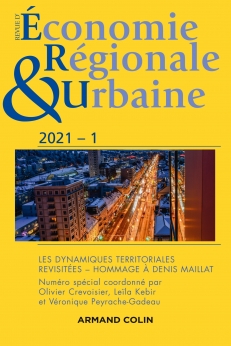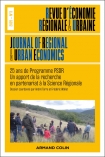
REVUE D'ÉCONOMIE RÉGIONALE ET URBAINE (1/2021)
Pour acheter ce numéro, contactez-nous
Recevez les numéros de l'année en cours et accédez à l'intégralité des articles en ligne.
Les zones transfrontalières ont leur propre capital territorial. Toutefois, il ne peut pas être la simple addition des composantes des zones frontières concernées. Bien souvent, il est qualifié, positivement ou négativement, par des spécificités découlant du jeu complexe des interactions, synergies, blocages et complémentarités, entre contraintes institutionnelles et processus d’intégration et de globalisation. L’objectif de cet essai est alors – dans un contexte de référence théorique encore ouvert – de dresser une typologie des différentes problématiques de développement. Cette démarche est proposée sur la toile de fond du capital territorial. Ainsi le croisement entre les trois articulations du capital territorial (productivité, clusterisation, emplacement) et les trois conceptions évolutives de la frontière (ligne de séparation, zone de contact, ouverte à l’horizon) donne lieu à un cadre théorique d’analyse et à un tableau typologique des effets frontières intéressant et stimulant pour une nouvelle génération d’analyses du terrain et des stratégies de politiques transfrontalières.
Cross-border areas have their own territorial capital. However, it cannot be mere summation of the individual components of the border areas concerned ; it is often qualified, positively or negatively, by its own specific features, arising from the complex interplay of interactions, synergies, blockages and complementarities of the cross-border dimension. The multi-faceted dimensions of transborder areas’ specificity represent a challenge for the regional science, which is emerging under a new light, between institutional constraints, integration processes and globalization. The goal of the article – within a theoretical framework which is still to be developed – is to detect the different issues concerning transborder areas’ development and to address a typology as a basis for their governance. This approach is proposed on the backdrop of the territorial capital of different transborder areas focusing on evolving types of spatial barriers. A new theoretical frame is developed crossing the three articulations of territorial capital (productivity, clusterisation and attractiveness) with the three evolving views of frontiers (barrier borders, contact zone, open space and gateway). The resulting typological matrix (Table 1) reports this frame and exemplifies the different emerging border effects while acting as a trigger for the studies of new strategies for transborder policies. Economic and institutional changes do not necessarily go hand in hand; this even requires paradigm shifts, even to the notion of "borderity", in order to govern the new border effects due to networking and transnational production assemblages. Concerning the forms of governance of border spaces, our typological analysis shows - in a non-prescriptive way - that in the pursuit of long-term dynamics, these should rather be defined by their inductive, functional and variable-geometry character. This approach includes a strong presence of the market and civil society, with a dimension of "looseness" that can only guarantee rapid adaptations to the pressing dynamics of the world economy.
